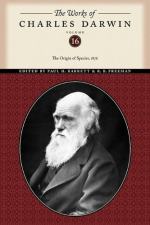
|
| Name: _________________________ | Period: ___________________ |
This test consists of 15 multiple choice questions and 5 short answer questions.
Multiple Choice Questions
1. What would a variety do in order to become a new species?
(a) Exceed in numbers from the parent species.
(b) Inter-breed.
(c) Migrate.
(d) Reduce in numbers.
2. Which species require more years for change?
(a) Inter-breeders.
(b) Sterile species.
(c) Slow breeders.
(d) Fast breeders.
3. As an example of a variation, what does Darwin indicate in Chapter 1 that is a change due to improved diet?
(a) Lower intelligence.
(b) Increased size.
(c) Higher intelligence.
(d) Decreased size.
4. In Chapter 1: Variation Under Domestication, what animal does Darwin give as an example for being perfectly adapted for catching its food?
(a) Bull.
(b) Tiger.
(c) Woodpecker.
(d) Beaver.
5. What aspect of organisms is not caused by chance?
(a) Size.
(b) Variation.
(c) Gender.
(d) Location.
6. Which term refers to a type of variation that is seen in most or all groups of organisms?
(a) Organism variation.
(b) Indefinite variation.
(c) Definite variation.
(d) Species variation.
7. What tends to occur in large groups of genera?
(a) They become varieties.
(b) They live over large areas.
(c) They divide into smaller groups.
(d) They never inter-breed.
8. What is one way to observe the change in a species in a controlled environment?
(a) Learn about extinct animals.
(b) Create hybrids.
(c) Observe wild animals.
(d) Observe captive animals.
9. What typically happens when varieties are inter-breed?
(a) Variations die out.
(b) Offspring are weaker.
(c) Variations increase.
(d) Offspring are stronger.
10. What is the difference between the two types of variations discussed in Chapter 1: Variation Under Domestication?
(a) Location of variation.
(b) Degree of variation.
(c) The species that variations happen to.
(d) The area affected by the variation.
11. What do Naturalists suggest is one definite distinction between a species and a variety?
(a) Size of groups.
(b) Geographical range.
(c) Life span.
(d) Domestication.
12. When is the only time a rational conclusion can be reached on a theory?
(a) You can never draw a conclusion in science.
(b) After a committee discussion and agreement.
(c) When one side comes up with more proof.
(d) When both sides have been considered.
13. What is the best example of traits that continue to vary?
(a) Mating habits.
(b) Migration characteristics.
(c) Primary sexual characteristics.
(d) Secondary sexual characteristics.
14. How might one explain the correlation of growth?
(a) Complication in selection.
(b) Natural selection's way to economize.
(c) A natural mistake.
(d) Natural selection changes the whole, not just a part.
15. What happens when two species from different climates interbreed?
(a) All traits are selected for.
(b) Traits favoring the previous climate are still selected for.
(c) Nothing.
(d) Some traits are not selected for.
Short Answer Questions
1. With respect to breeders, what leads to the development of different varieties of species when breeding?
2. Why do domestic ducks have lighter wings and heavier feet then wild ducks?
3. Which term refers to organisms with no distinct gender?
4. What do naturalists connect with species that have two or three variations?
5. What is one function that cave dwelling animals lost through natural selection?
|
This section contains 479 words (approx. 2 pages at 300 words per page) |

|




